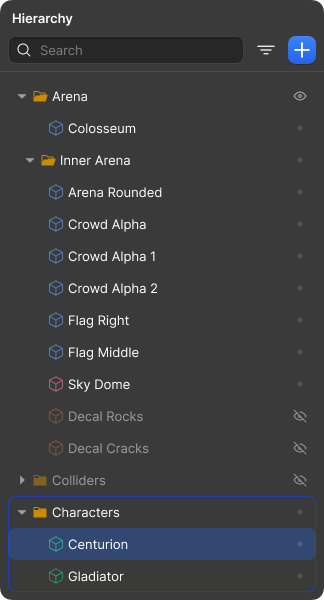Hierarchy
Overview
Objects may further be grouped into layers, which may in turn be locked, hidden or grouped into folders.
This is particularly useful in instances where multiple objects need to be locked/hidden all at once, where different layers of objects need to be displayed at differing points of time within a game, or simply to prevent members of your development team from working on the same level objects simultaneously.
As an example, a cinematic demonstrating the destruction of a village could be designed to use different layers of assets before and after the event of destruction. By default the Hierarchy is displayed in the bottom-left panel of the Viewport.
Menu
The Hierarchy Main Menu can be found under the tree icon in the top-right corner and contains the following options:
Context Menus
Right-clicking an object or layer in the Hierarchy opens a menu with the following options.
List View
Clicking on the titles of any of the columns within the Hierarchies list of objects, layers and folders, automatically sorts the contents of that column in ascending/descending alphabetical order. You may further choose to display/hide specific columns via the context menu generated by right-clicking a column title.
Search and Filtering
Search
Located at the top of the Hierarchy panel, the Search Bar enables filtering between listed objects on the basis of their names.
For instance, consider a level containing objects named tree, shovel, dagger and mountain 1; searching for the term NEED via the Search Bar will cause the Hierarchy to list only these objects.
Filter
The Filter button meanwhile allows users to describe specific criteria by which the Hierarchy must list objects. This criteria is based on the values of various object and layer properties, which can be displayed in columns using the context menu described in section above. Clicking the Filter button adjacent to the Search Bar reveals options to Add/Clear Criteria and Save/Load custom filters.
Nesting and Links
Objects can be moved to an existing group or layer by dragging and dropping them to the destination group/layer’s listing.
Dragging an object onto another object however causes both objects to be linked; if both the dragged and target objects are Entity objects such that the former has bones however, a menu is displayed to allow for linking to a specific bone of the target object.
Hiding
The visibility of objects, layers and folders within a level is indicated by the eye icon column of the Hierarchy, as shown in the image below. The open eye
Locking
When an object is ‘locked’, it cannot be edited. The lock column indicates if an object, layer or folder has been locked, as shown in the image below. A locked object is indicated by the closed lock icon, while open lock indicates an unlocked object. Clicking either icon will unlock/lock the corresponding object.
Feedback
Please be sure to submit issues or feature requests through the embedded feedback form. In the event it is a major issue please contact us directly through Discord.













